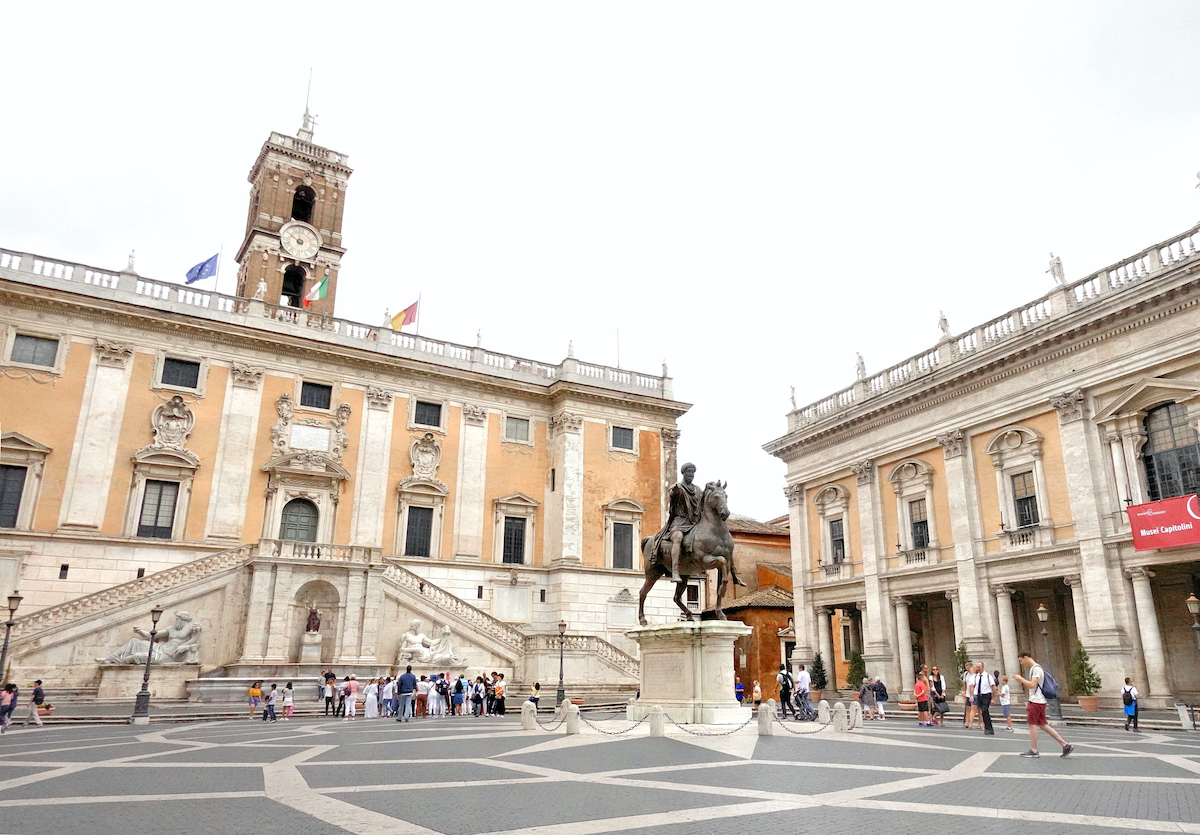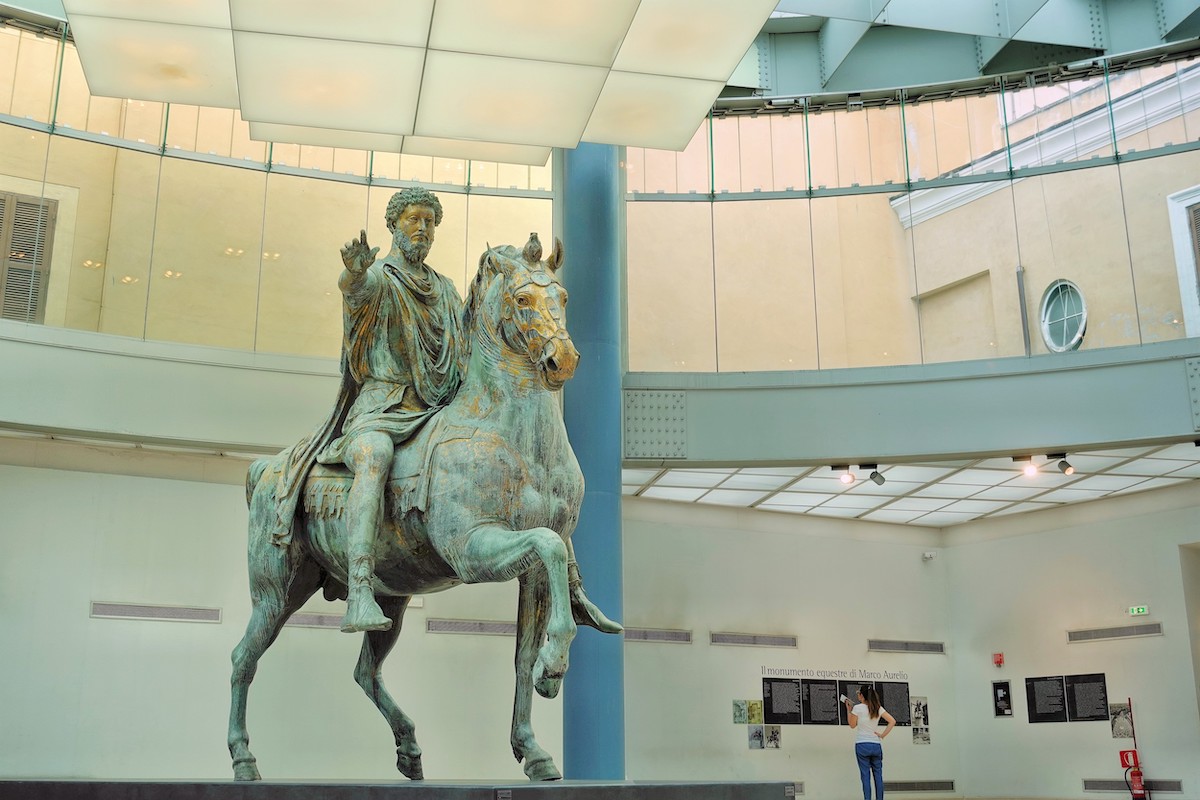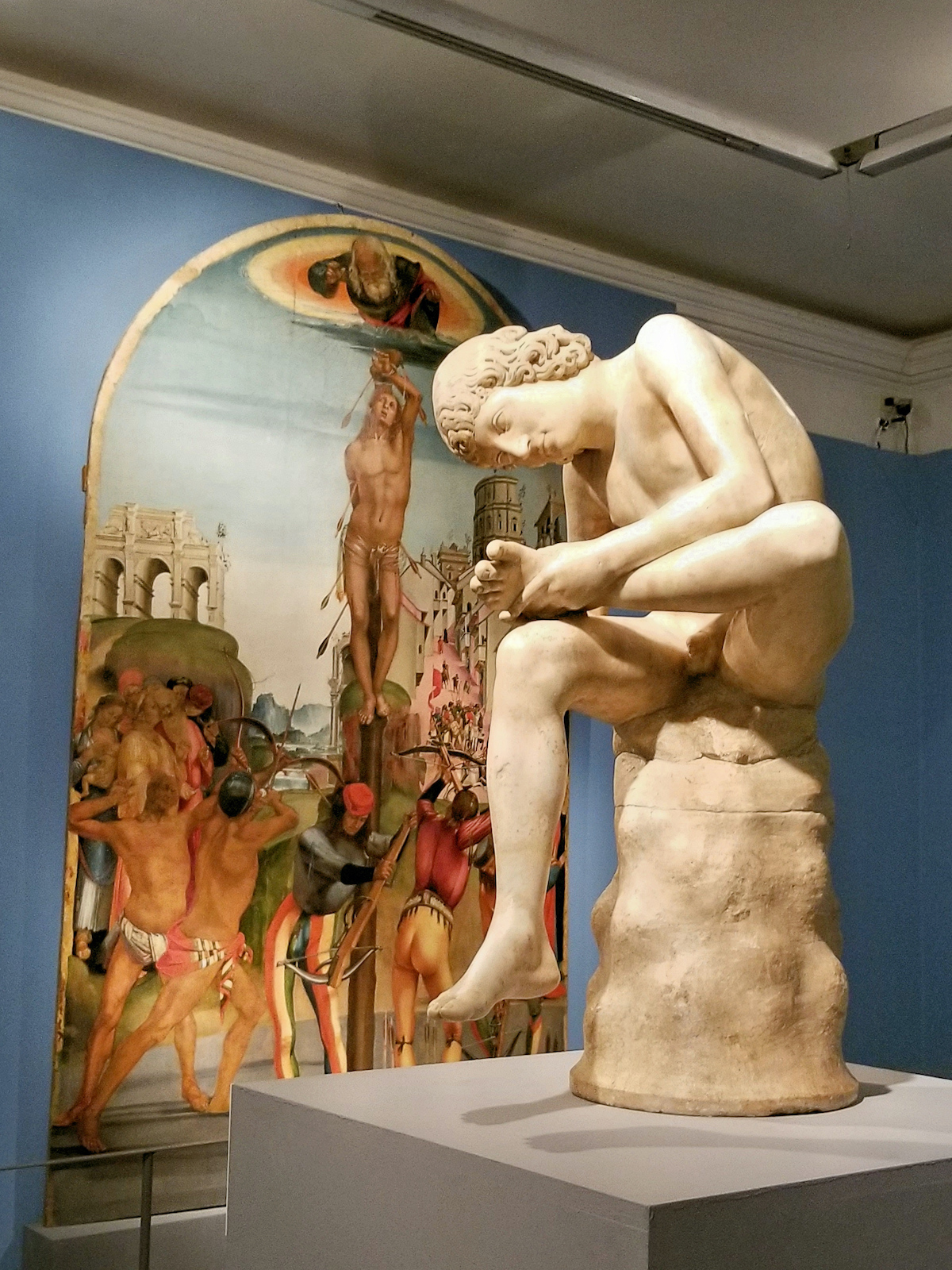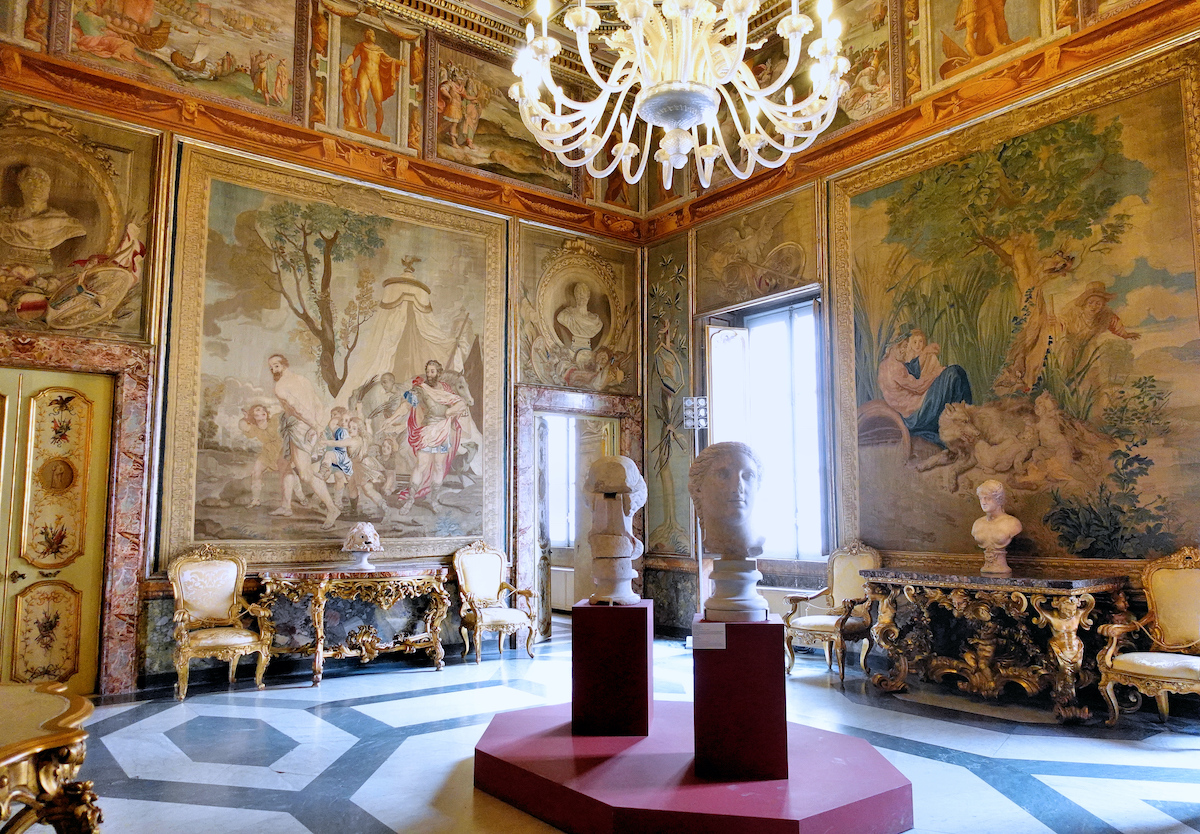Last Updated on December 20, 2025 by Emma Fajcz | Published: June 24, 2022
One of the first places you’ll stumble upon when you visit Rome is most likely the Piazza Campidoglio. Michelangelo designed this round piazza, which is marked by the looming statues of Castor and Pollux. Here you’ll find Rome’s famous town hall, but also two palazzi that make up the Rome Capitoline Museums.

It is referred to as “Museums” plural as their collection expands to multiple buildings. This is a historic museum about Rome that illuminates the city’s long history. Keep reading to discover why it it is definitely worth a visit during a trip to Rome!
To help you navigate your visit a bit better, here’s our guide to the Rome Capitoline Museums.
The Capitoline Hill
The Capitoline Museums got their name from their location, right on top of one of Rome’s famous seven hills – The Capitoline Hill.
You might have heard of the tribe of Sabines, a neighboring tribe that played a major part in the foundation of Rome. It was here on the Capitoline they originally settled. Over time when Rome developed into a larger culture, they made this hill one of their most sacred – where their Temple of Jupiter was located.
Overlooking the Roman Forum, this was a holy site to Romans, where also many administrative tasks were carried out. Thanks to its extensive history, the Rome Capitoline Museums are able to show great insight into the history of the city.

The History of the Rome Capitoline Museums
The Rome Capitoline Museums are actually a collection that spans multiple buildings. The main ones you will likely visit, located in Piazza del Campidoglio are Palazzo dei Conservatori and Palazzo Nuevo.
These museums date back to 1471 and Pope Sixtus IV. He donated a group of historic bronze statues to the “people of Rome.” That being said, it was not formally made into a public museum until 1734. Even so, it is one of the oldest museums in the world.
Today the collection includes many ancient sculptures, paintings, and other artifacts all closely tied to the history of Rome itself.
The three palazzi of Piazza del Campidoglio are in fact all linked underground. The central one, Palazzo Senatorio, houses Rome’s town offices. Built in the 12th century, it was later adjusted in the 1500s to fit Michelangelo’s design of the Piazza.
Palazzo dei Conservatori, located to the right, was built in the 16th century with a facade design by Michelangelo. Finally, Palazzo Nuovo, to the left, was built in the 17th century to mirror Palazzo dei Conservatori.

Rome Capitoline Museums: The Highlights
Colossus of Constantine, 312–315 AD
This work of art is a remnant of a much larger-than-life statue of Emperor Constantine, who is often mentioned for his bringing of Christianity to the Empire. You’ll see a hand, and his head, but much of the rest of the statue was never found. This is because they believe only the extremities were carved in stone, whereas the main body was simply a structure, to be covered with real fabric, dressing him.

Bust of Commodus as Hercules, late 2nd century
Does the name Commodus ring any bells? Fans of Gladiator probably remember him as being quite the piece of work. The film didn’t lie, in fact, Commodus was such a nightmare that once his reign was over, there was mass destruction of depictions of him. However, this one piece survived, showing off his ego and aligning himself with the great hero Hercules.

Capitoline She-Wolf, 5th Century
The She-Wolf became the symbol of the Italian capital. This was an early depiction of the legend of the founding of Rome. As the story goes, the brothers Romulus and Remus were abandoned and came to be nursed by a She-Wolf in their early years. Romulus would go on to found the city we know today.

Equestrian Statue of Marcus Aurelius, 176 AD
You’ll have already seen the copy placed in the main piazza in front of the museums, but inside you’ll get the chance to see the 2nd-century original up close. An impressive statue on its own, its fame comes from the fact it is the only equestrian statue to have remained intact from the period. Due to its size, and the fact it is made of bronze (which is easily corroded), it’s wondrous that it has survived to this day.

The Dying Gaul, 1st or 2nd century AD
The Dying Gaul is an unforgettable work of art. It portrays one of Rome’s enemies at a moment of defeat. Caught in his last moments, it is a moving sculpture, able to draw in the passing visitor. While many might assume that this is a Renaissance work, this emotional sculpture actually dates back to the 2nd century!

Capitoline Venus, 2nd century
The Capitoline Venus is most likely a copy of a 2nd-century BC sculpture depicting the goddess, by the Hellenistic artist Praxiteles. The work is a classic depiction of the Goddess, an image repeated throughout history.
Rome Capitoline Museums’ Hidden Gems
While the highlights might share some of the works you’ve heard of before, here are a few extra gems that are hiding in Rome’s Capitoline Museum collection.
Cupid and Psyche, 2nd century
Much like the Venus of the Capitoline, this is a Roman copy of a Hellenistic original. It displays a sentimental moment between a child-like Cupid and Psyche, showing an innocent love between the two mythical figures.

Boy with Thorn (Spinario), 2nd Century
This early bronze depicts a simple, subtle moment of daily life. It is for this reason that it is so intriguing. At a time when most decorative sculpture or art was for religious or governmental reasons, this is simply an art piece showing a snippet into an average moment.

Medusa by Gian Lorenzo Bernini, circa 1630s
Jumping to another era, the masterpieces of the Rome Capitoline Museums aren’t only from the ancient past. The museum holds a collection also from the Renaissance and Baroque times. One great work from this time is the bust of Medusa by Rome’s great sculptor: Bernini. A great piece for its attention to detail and raw emotion in the expression on Medusa’s face.

St. John the Baptist by Caravaggio, 1602-03
Found in the Capitoline Museum’s Painting Gallery are a few lesser-known Caravaggio works that are worth a peek at. The first is a depiction of St. John the Baptist, shown as an adolescent but still with his telling signs of the ram and red cloak.
A Little Guide to the Rome Capitoline Museums
Depending on your interests and time, you might be able to soak up everything the Capitoline has to offer, or you may need to rush through to the highlights. Either way, this breakdown of the halls of the Capitoline Museums will help you plan your visit accordingly.
Starting from the Palazzo dei Conservatori, where the ticket office and main entrance are, you’ll mainly find sculptures from Ancient Rome, but also a few Greek and Egyptian examples.
In Palazzo dei Conservatori you’ll find the most recent addition to the Capitoline Museum. This “New Wing” is a modern wing, mirroring the outside piazza, covered with glass windows for full lighting. Here you can see the original bronze sculpture or Marcus Aurelius as well as a bronze of Constantine. This wing also shares contextual information to better understand the importance and evolution of the Capitoline hill in Rome’s history.
Moving on to the main staircase, Marcus Aurelius fans can catch a glimpse at honourary reliefs once decorating a monument to him.
On the second floor is the elegant “Conservator’s Apartment.” It contains the She-Wolf, Rome’s most important sculpture and an ancient symbol of the city’s legendary founding. This space also an interesting hall for 16th and 17th centuries art lovers, as many frescos and decorative elements in situ are originally from that era.
Finally, on the third floor sits the Capitoline Art Gallery. This is where you will find the majority of the paintings from the Capitoline collection. Here you will find a mix of artistic eras from the early renaissance to baroque. This is also home to the museum’s coin collection.

To connect with Palazzo Nuovo, you’ll take the underground corridor of the Galleria di Congiunzione. This gallery, though finalized in the 1930s includes remnants of 2nd-century Roman residences found built into the hill. Here you can peek at some of these archaeological remains as well as view the museum’s epigraph collection.
Palazzo Nuovo is two floors and primarily houses ancient Roman artifacts including intricate sarcophagi, mosaics, and sculpted busts. Most notably, here you will find the beautiful marble “Dying Gaul” and the Capitoline Venus.
Visiting the Rome Capitoline Museums: Practical Info
The entrance to the Capitoline Museums is located up the stairs on the right of the Altare della Patria in Piazza Venezia. After a little climb, you’ll be face to face with the impressive copy of the Equestrian Statue of Marco Aurelio. Head to your right to reach the ticket office.
Tickets can be purchased on-site, or if you prefer they are bookable online in advance. They are 13€ on site, or 14€ if you buy online in advance. This admission ticket also gives you access to the temporary exhibitions within the museum.
If you think you’d really like to take your time and visit also the collection at Centrale Montemartini, you might want to opt for the Capitolini Card. This gives you 7-day access to the museums and exhibitions, as well as the museum at Centrale Montemartini. This card costs 16€ if you buy it at the ticket office, and 17€ if you buy it online in advance.
Insider’s Tip: if you just want a quick peek in the museum, there is half-off admission every Wednesday two hours before closing time (from 5:30 pm).
You’ll find the Rome Capitoline Museums open every day from 9:30 am to 7:30 pm. There are special closures on January 1, December 25, and May 1.
Rome Capitoline Museums FAQ
How much does entrance cost?
Tickets bought on-site cost 13€, while if bought online in advance there is an extra 1€ fee, making them 14€.
If you’d like to return again or visit the Capitoline’s extended collection at the Centrale Montemartini, you may prefer to purchase the Capitolini Card which gives you access to all collections for 7 days. This Card costs 16€ when purchased at the ticket office, or 17€ purchased online in advance.
Where can I book a ticket?
Tickets can be bought right on-site or purchased in advance via the Capitoline Museum’s official website.
Do I need a guide?
To visit the Rome Capitoline Museums, a guide is not entirely necessary as you will find plenty of information onsite. The museums offer a video and audio guide to help you gain a better understanding of the permanent collection. However, if you do prefer an in-person guide, you will have to book with a third party, rather than with the museum directly.
How long will a visit take?
Taking your time to see the whole permanent collection and temporary exhibitions, a longer visit could take you about 3 hours. However, if you are visiting just to get a glimpse or to view the main highlights, you can cut your visit to only an hour, an hour, and a half.
Can I bring my pet inside?
No, animals and pets cannot come inside the Capitoline Museum.
Is there somewhere to eat in the Rome Capitoline Museums?
There is an external bar for visitors located at Piazzale Caffarelli, 4, where you can find a bar and refreshment area.
Where should we eat after the Capitoline Museums?
Being right in the center of Rome, there are plenty of fantastic spots to eat nearby. Let us inspire you with these recommendations for the best places to eat in Rome.









